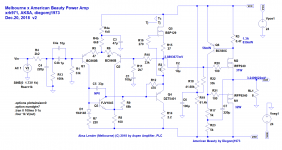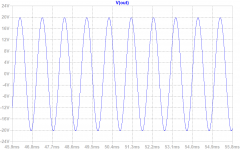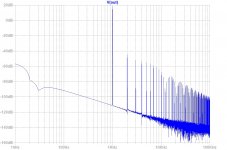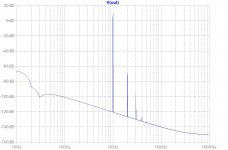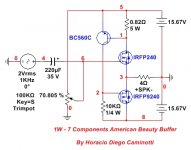As is, negative side clips earlier due to Vgs at ~-19V, you need some kind of bootstrap or dual 25V for 40Vpp.
Melbourne X Ambeau w/ Bootstrap
Ok, I put a 220u bootstrap on lower MOSFET to avoid lower clip. At 1.3A bias and 24v rails it is getting to 40Vpp without clipping. THD is about 0.51% at the max operating spot. Still H2 dominant but lots of higher order stuff.
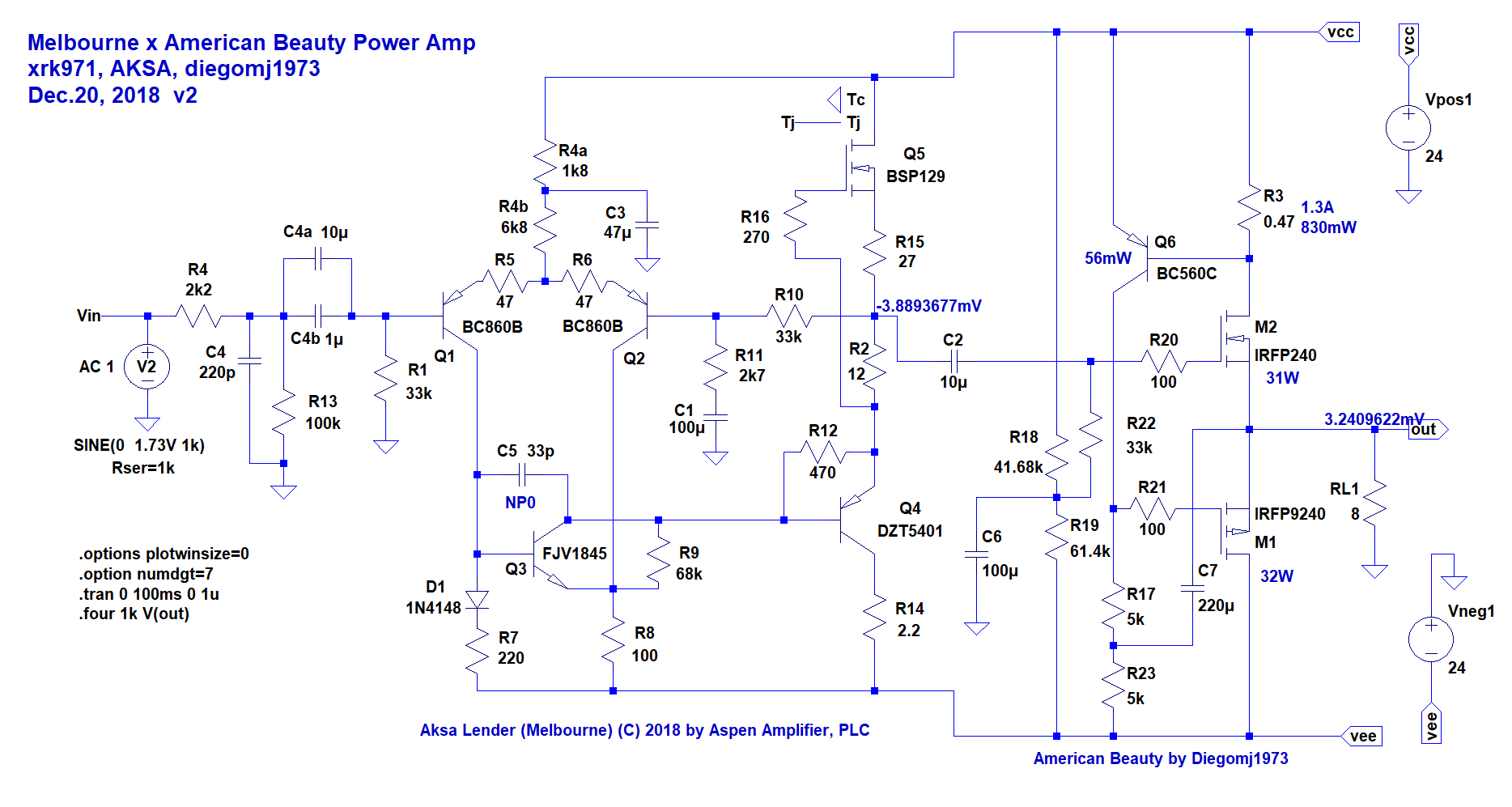
Predicted O-scope trace for 40Vpp into 8ohms:
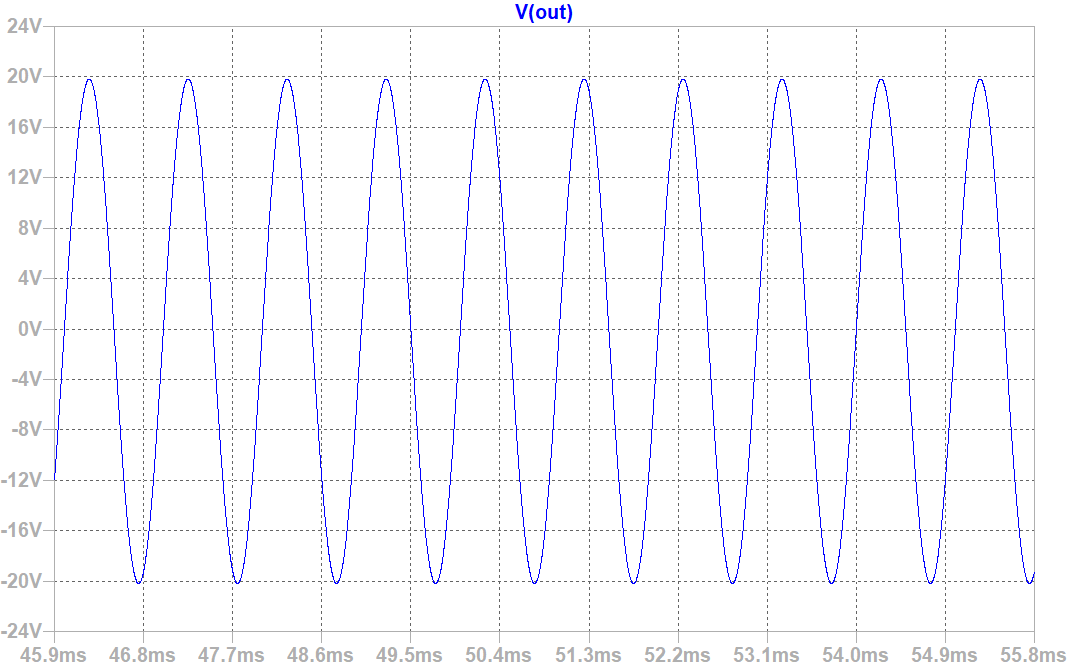
At 22.6Vpp (8wrms), I am getting 0.09%THD:
But FFT looks not very good - too much higher order stuff going on here:
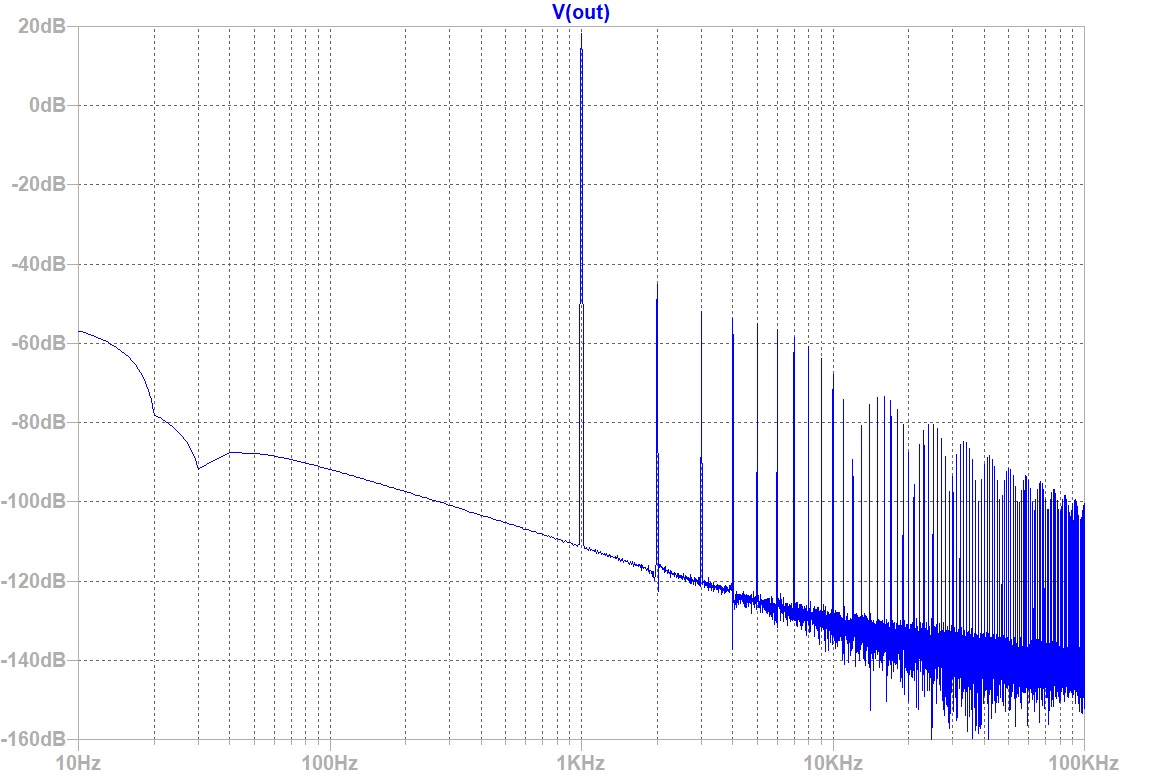
And even at 8Vpp (1wrms into 8ohms), it doesn't look as good as when I was running a lower bias current at 18v rails:

Recall, this was 8Vpp into 8ohms with 560mA bias and 18v rails:
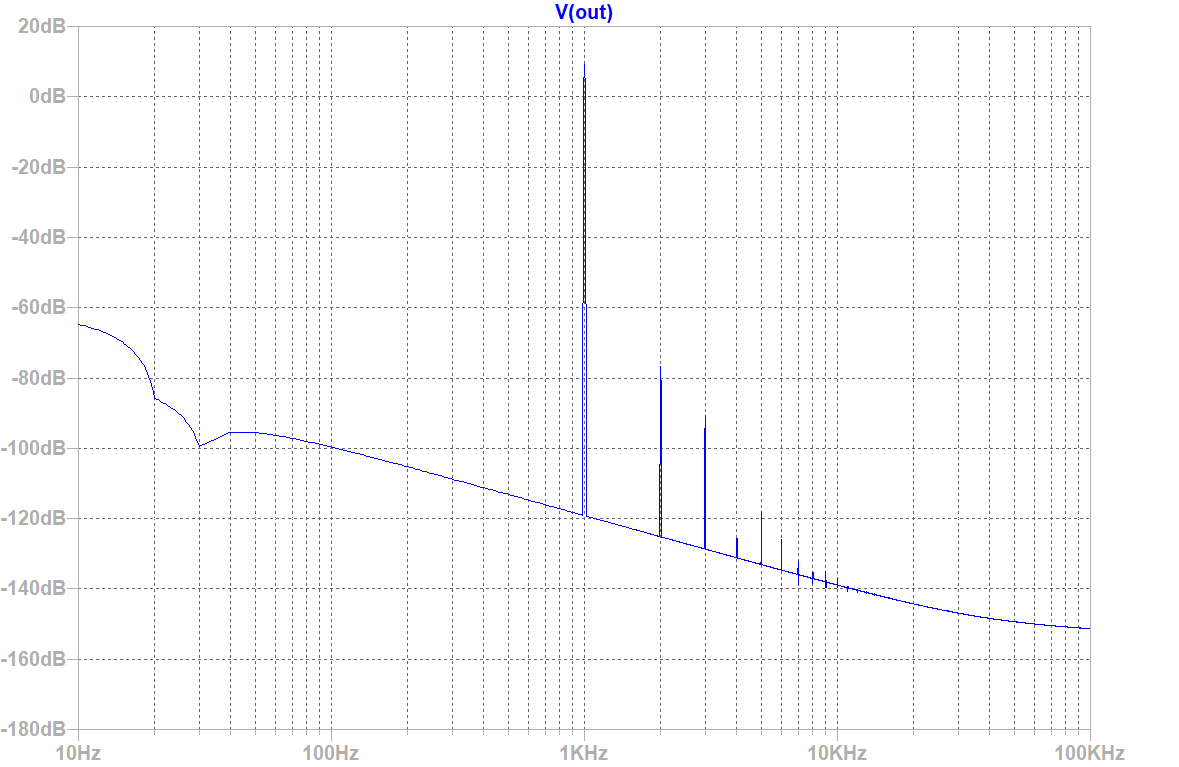
Ok, I put a 220u bootstrap on lower MOSFET to avoid lower clip. At 1.3A bias and 24v rails it is getting to 40Vpp without clipping. THD is about 0.51% at the max operating spot. Still H2 dominant but lots of higher order stuff.
Predicted O-scope trace for 40Vpp into 8ohms:
Code:
Harmonic Frequency Fourier Normalized Phase Normalized
Number [Hz] Component Component [degree] Phase [deg]
1 1.000e+03 2.005e+01 1.000e+00 -0.18° 0.00°
2 2.000e+03 9.281e-02 4.628e-03 90.47° 90.65°
3 3.000e+03 4.360e-02 2.174e-03 1.39° 1.57°
4 4.000e+03 1.070e-02 5.334e-04 -85.68° -85.50°
5 5.000e+03 6.474e-03 3.228e-04 -8.79° -8.61°
6 6.000e+03 9.313e-03 4.644e-04 -94.47° -94.29°
7 7.000e+03 4.113e-03 2.051e-04 171.87° 172.05°
8 8.000e+03 1.915e-03 9.550e-05 -84.02° -83.84°
9 9.000e+03 4.116e-03 2.053e-04 179.26° 179.44°
Total Harmonic Distortion: 0.518127%(0.518645%)At 22.6Vpp (8wrms), I am getting 0.09%THD:
Code:
Harmonic Frequency Fourier Normalized Phase Normalized
Number [Hz] Component Component [degree] Phase [deg]
1 1.000e+03 1.142e+01 1.000e+00 -0.17° 0.00°
2 2.000e+03 7.974e-03 6.982e-04 90.61° 90.79°
3 3.000e+03 3.647e-03 3.194e-04 0.56° 0.73°
4 4.000e+03 2.926e-03 2.562e-04 -90.05° -89.88°
5 5.000e+03 2.527e-03 2.213e-04 179.86° 180.04°
6 6.000e+03 2.117e-03 1.854e-04 89.70° 89.87°
7 7.000e+03 1.698e-03 1.487e-04 -0.68° -0.51°
8 8.000e+03 1.292e-03 1.131e-04 -91.21° -91.03°
9 9.000e+03 9.092e-04 7.961e-05 178.27° 178.45°
Total Harmonic Distortion: 0.088304%(0.088724%)But FFT looks not very good - too much higher order stuff going on here:
And even at 8Vpp (1wrms into 8ohms), it doesn't look as good as when I was running a lower bias current at 18v rails:
Recall, this was 8Vpp into 8ohms with 560mA bias and 18v rails:
Attachments
Last edited:
Monitor current of M1 and M2. You want a diode in series with R3 like what I did on post #13 and adjust various resistor values to stay in class A operation up to clipping to avoid higher order harmonics. Takes a little time but achievable. Versatile circuit, can be set at various operating points to fit different sonic preferences and other needs.
I'm getting ~5% with your posted circuit.... THD is about 0.51% at the max operating spot. Still H2 dominant but lots of higher order stuff....
I'm getting ~5% with your posted circuit.
Here, try this - all models included in LTSpice schematic file: "Melbourn-X-AmBeau-bootstrap-v2-FFT.asc"
Attachments
This topology is not as efficient as the ALPHA which used the Aleph active CCS but with a P-channel MOSFET below the Aleph CCS. I had to increase bias current to 2.8A in order to prevent amp from going into Class B.
Sorry, previously model got messed up. Yes, not as clean as Aleph OS on higher power but nice on low power.
Yes, I think this is suited for a headphone amp as power requirements are less. Great performer in that regard though.
Ok, I put a 220u bootstrap on lower MOSFET to avoid lower clip. At 1.3A bias and 24v rails it is getting to 40Vpp without clipping. THD is about 0.51% at the max operating spot. Still H2 dominant but lots of higher order stuff.
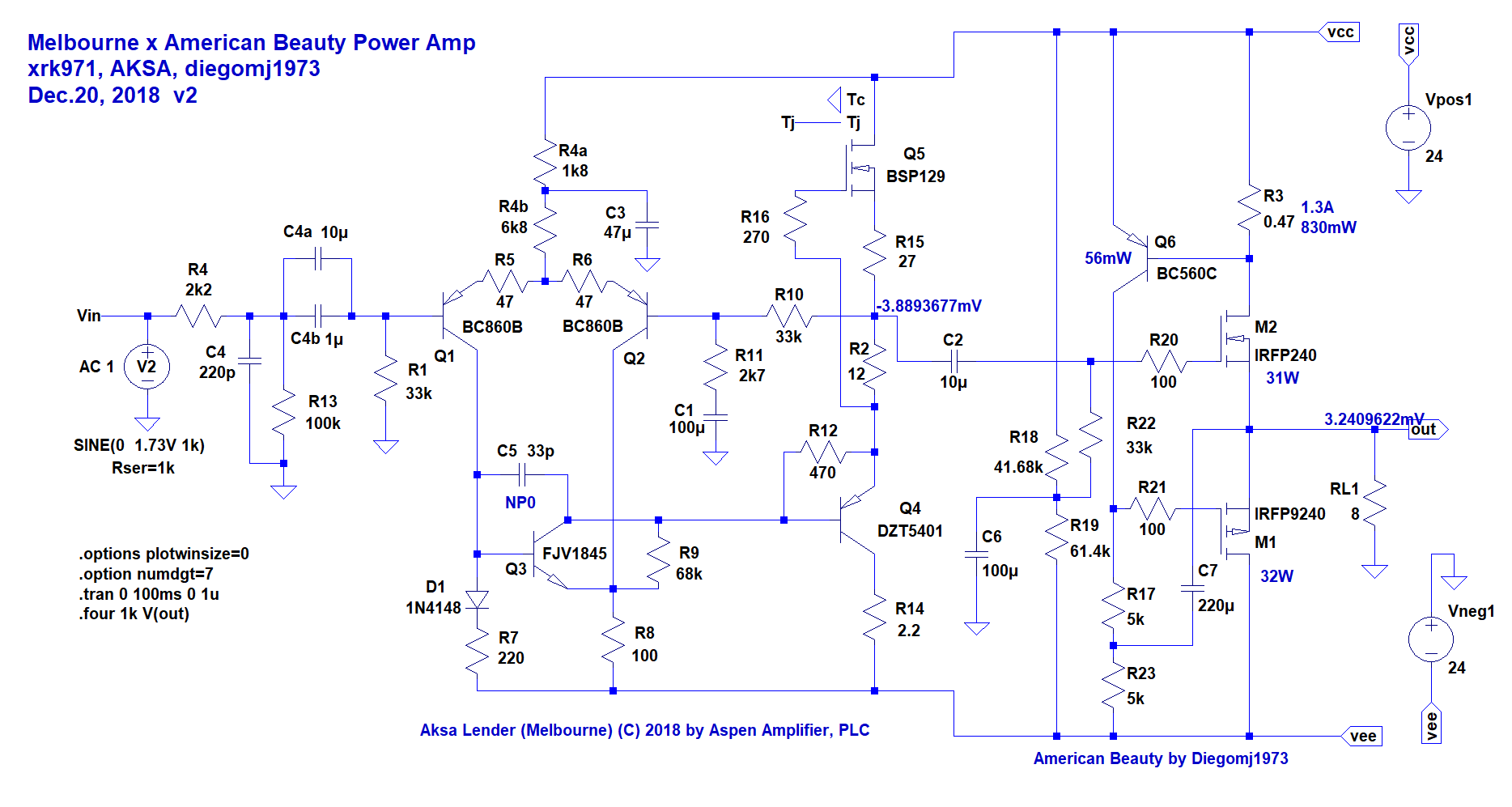
Predicted O-scope trace for 40Vpp into 8ohms:
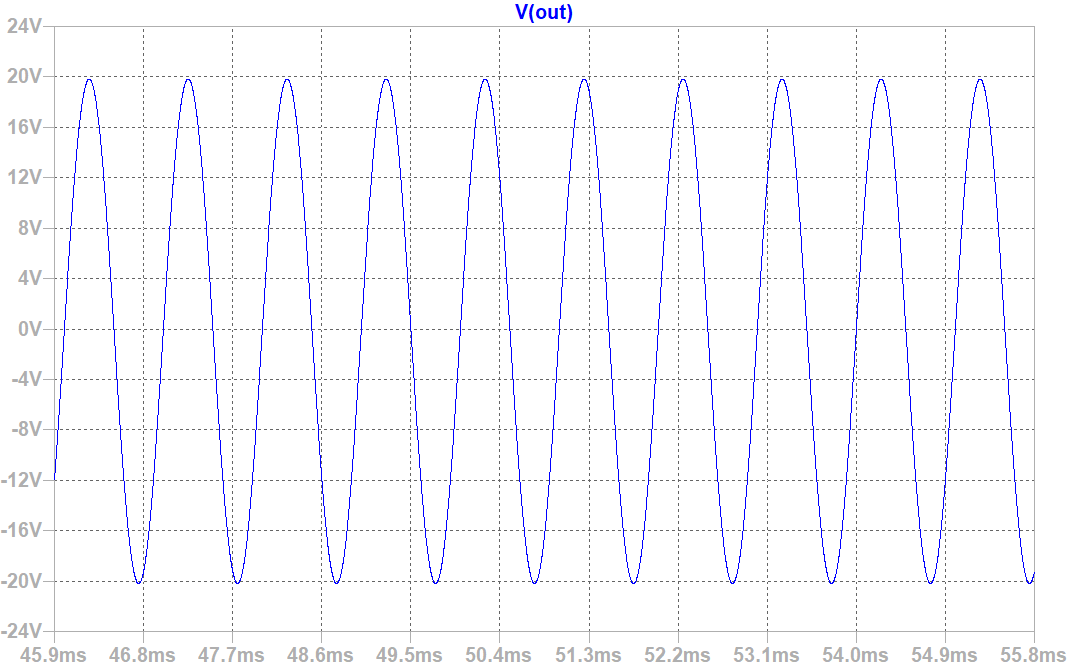
At 22.6Vpp (8wrms), I am getting 0.09%THD:Code:Harmonic Frequency Fourier Normalized Phase Normalized Number [Hz] Component Component [degree] Phase [deg] 1 1.000e+03 2.005e+01 1.000e+00 -0.18° 0.00° 2 2.000e+03 9.281e-02 4.628e-03 90.47° 90.65° 3 3.000e+03 4.360e-02 2.174e-03 1.39° 1.57° 4 4.000e+03 1.070e-02 5.334e-04 -85.68° -85.50° 5 5.000e+03 6.474e-03 3.228e-04 -8.79° -8.61° 6 6.000e+03 9.313e-03 4.644e-04 -94.47° -94.29° 7 7.000e+03 4.113e-03 2.051e-04 171.87° 172.05° 8 8.000e+03 1.915e-03 9.550e-05 -84.02° -83.84° 9 9.000e+03 4.116e-03 2.053e-04 179.26° 179.44° Total Harmonic Distortion: 0.518127%(0.518645%)
But FFT looks not very good - too much higher order stuff going on here:Code:Harmonic Frequency Fourier Normalized Phase Normalized Number [Hz] Component Component [degree] Phase [deg] 1 1.000e+03 1.142e+01 1.000e+00 -0.17° 0.00° 2 2.000e+03 7.974e-03 6.982e-04 90.61° 90.79° 3 3.000e+03 3.647e-03 3.194e-04 0.56° 0.73° 4 4.000e+03 2.926e-03 2.562e-04 -90.05° -89.88° 5 5.000e+03 2.527e-03 2.213e-04 179.86° 180.04° 6 6.000e+03 2.117e-03 1.854e-04 89.70° 89.87° 7 7.000e+03 1.698e-03 1.487e-04 -0.68° -0.51° 8 8.000e+03 1.292e-03 1.131e-04 -91.21° -91.03° 9 9.000e+03 9.092e-04 7.961e-05 178.27° 178.45° Total Harmonic Distortion: 0.088304%(0.088724%)
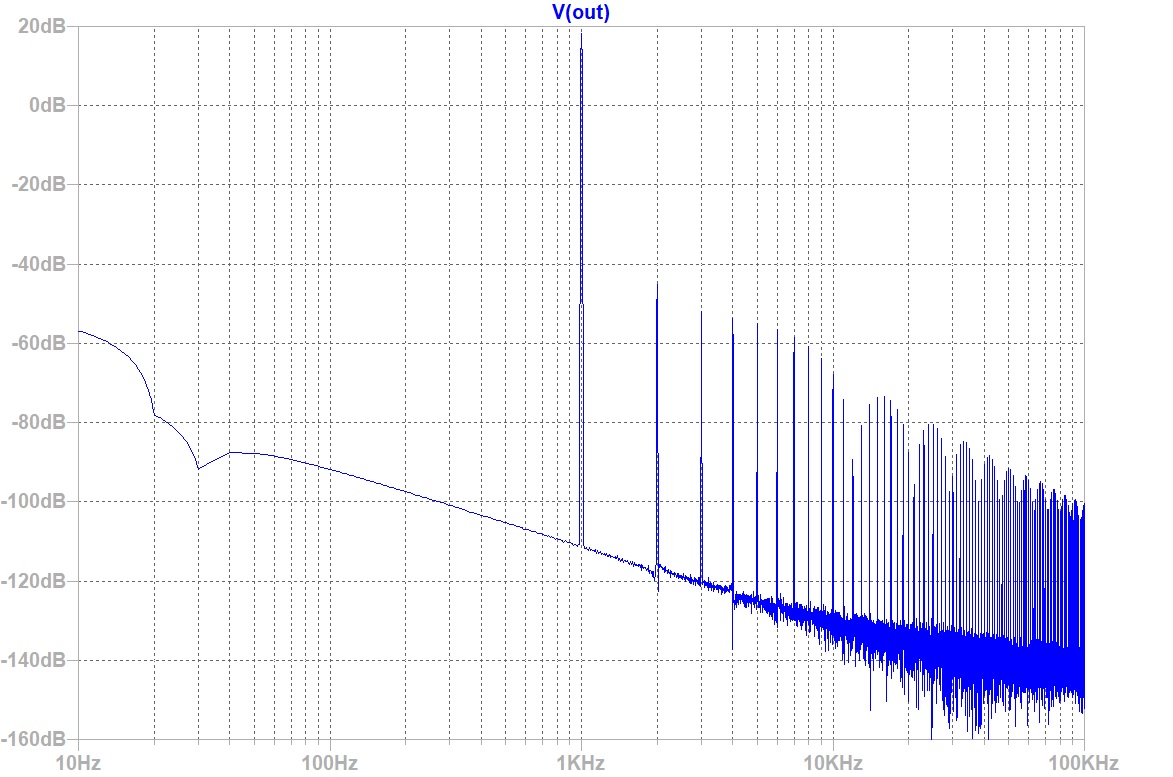
And even at 8Vpp (1wrms into 8ohms), it doesn't look as good as when I was running a lower bias current at 18v rails:
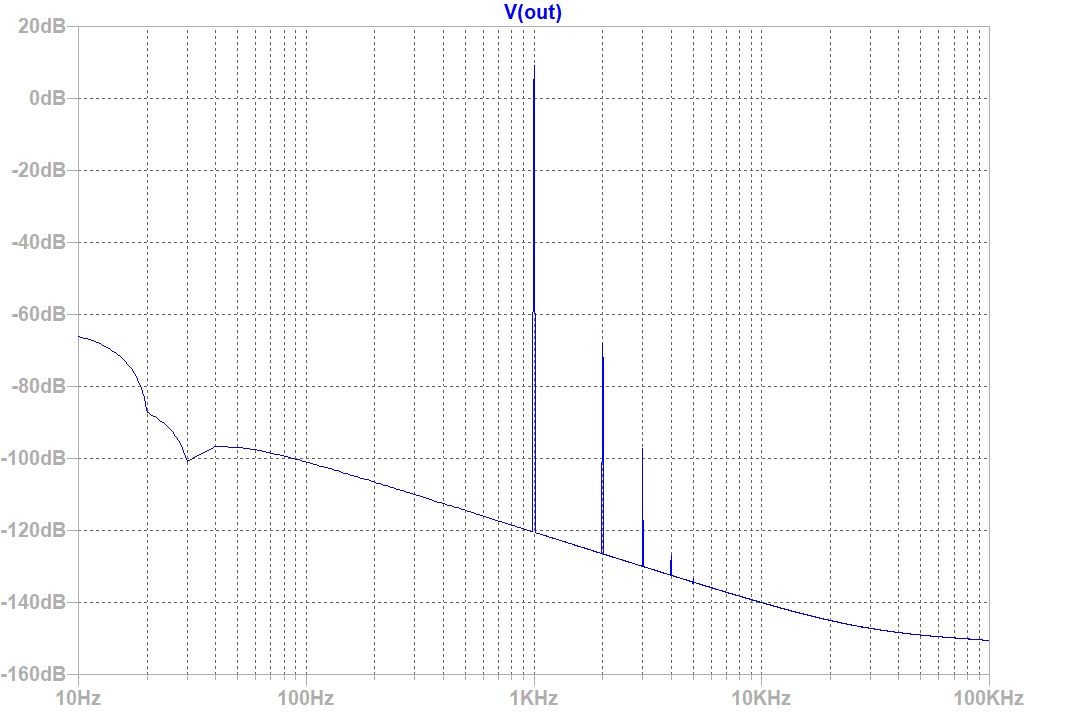
Recall, this was 8Vpp into 8ohms with 560mA bias and 18v rails:

The bootstrap implemented with C7 helps significantly in reducing the THD, but it is also a fact that this bootstrap visibly modifies the spectrum of that distortion. This bootstrap tends to decrease the H2, but it alters the desired ratio of this H2 to the higher Hs.
You could see that by substituting R17 and R23 for a trimpot of 10 K (result of adding R17 and R23 values) and looking for how the spectral distribution of the point-to-point distortion is modified. Something similar to what happens in the DLH.
Last edited:
I noticed that when testing bootstrap on the Melbourne X M2 as well, and decided not to use it. The Mu-follower might be worth a try though - but not sure how to implement that here as the CCS feedback is the base of the BC550.
I noticed that when testing bootstrap on the Melbourne X M2 as well, and decided not to use it. The Mu-follower might be worth a try though - but not sure how to implement that here as the CCS feedback is the base of the BC550.
The bootstrap tends to raise the levels of H4, H5 and H6 and, according to the type of specific adjustment, can raise the levels of H3 and H8, in relation to the case that does not use it (where the H2 predominates over the level of the higher Hs). What the bootstrap can effectively do is reduce the THD markedly, but with a profile that we may not like, necessarily.
Thank you Diego, that is very interesting and I'm quite sure that you are absolutely right. I think you are really on to this harmonic profile issue, and salute you for your thoughts.
Hugh
Hugh
I upload a version with a minor change in the connection of one of the terminals of the trimpot (assuming an alteration in its adjustment as well). This change reduces the power dissipation of the trimpot to only a quarter of the previous one. Some changes not visible in simulators, but possibly visible with measuring instruments, are the distortion and thermal noise that now would have to be reduced very marginally (any small effort, although small, is welcome).
Regards
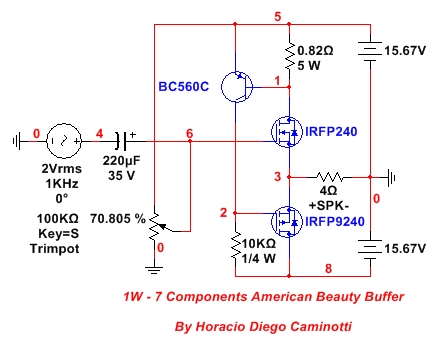
Regards
Attachments
Ignore the plot in post 24! I forgot to connect the power supply bypass caps 😀. Looks much better now - THD down to 0.002%
View attachment 722752
Sorry for off-topic posting here but this got me curious. Is it generally accepted that power supply bypass caps (I presume these are small film or ceramics across the main filter caps, but correct me please) helps get rid of 2xmains frequency noise from the PSU? I am seeing a very similar noise pattern from my F6 PSU and wonder if this is worth trying...?
Im thinking about breadboarding this novel circuit and am wondering what would happen to the dc offset mechanism if i were to put a filter like one in the photo right at the input. Actually, my modular preamp already has that filter built in, thats why.
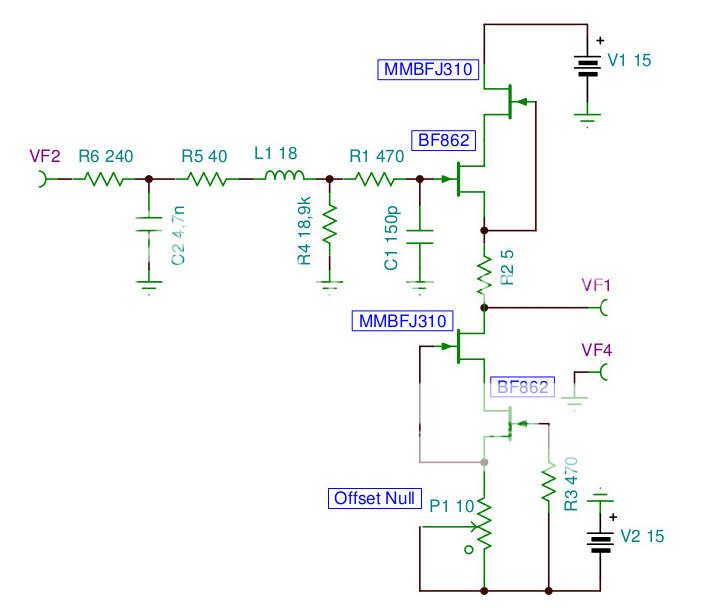

- Home
- Amplifiers
- Solid State
- 1W - 7 Components American Beauty Buffer
